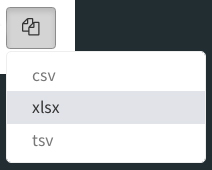Using the downloadFile Shiny Module
Dr. Connie Brett
2025-09-02
Source:vignettes/downloadFile-module.Rmd
downloadFile-module.RmdOverview
Purpose
This Shiny Module provides a consistent-looking and easy-to-use button that facilitates single or multiple types of file downloads.
Features
- Auto-adjusts the button image and styling for single or multiple downloads
- Ability to link different data sets to different file types if desired
- Incorporates tooltips and drop-downs automatically
- Converts data to various download types
- Requires minimal code (see the Usage section for details)
Usage
Shiny Module Overview
Shiny modules consist of a pair of functions that modularize, or package, a small piece of reusable functionality. The UI function is called directly by the user to place the UI in the correct location (as with other shiny UI objects). The module server function that is called only once to set it up using the module name as a function inside the server function (i.e. user-local session scope. The first function argument is a string that represents the module id (the same id used in module UI function). Additional arguments can be supplied by the user based on the specific shiny module that is called. There can be additional helper functions that are a part of a shiny module.
The downloadableTable Shiny Module is a part of the periscope2 package and consists of the following functions:
The downloadFile Shiny Module is a part of the periscope2 package and consists of the following functions:
- downloadFileButton - the UI function to place the button in the application.
- downloadFile - the server function to be called inside server_local.R.
- Helper Functions:
- downloadFile_ValidateTypes - will check a given list of file types and warn the caller if the list contains an invalid or unsupported type.
- downloadFile_AvailableTypes - will return a vector of supported file types.
downloadFileButton
The downloadFileButton function is called from the ui.R (or equivalent) file in the location where the button should be placed. This is similar to other UI element placement in shiny.
The downloadFileButton function takes the unique object ID for the UI object.
The next two arguments (downloadtypes and hovertext) set the file types the button will allow the user to request and the tooltip text.
If only one download type is given the button will be a single-download type of button that starts the specified download when the button is pressed. The button will look like:

If more than one type is given there will be a dropdown choice given to the user when the button is pressed and the download will start when the choose one of the types. The dropdown choices will be in the order given by the call to the function. The button and dropdown will look like:


# Inside ui_body.R or ui_sidebar.R
#single download type
downloadFileButton(id = "object_id1",
downloadtypes = c("csv"),
hovertext = "Button 1 Tooltip")
#multiple download types
downloadFileButton(id = "object_id2",
downloadtypes = c("csv", "tsv"),
hovertext = "Button 2 Tooltip")downloadFile
The downloadFile function is called directly. The call consists of the following:
Note on Excel file support: For xlsx files, the
module will first attempt to use openxlsx2 if available,
then fall back to openxlsx, and finally use
writexl if neither is available. We recommend
openxlsx2 for best performance with Excel files.
- the unique object ID that was provided to downloadFileButton when creating the UI object
- the logging logger to be used
- the root (prefix) of the downloaded file name to be used in the browser as a character string or reactive expression that returns a character string
- a named list of functions or reactive expressions
that provide the data (see below).
- It is important that the types of files to be downloaded are matched
to the correct data function in the list.
- The function/reactive expression names are unquoted - they will be called at the time the user initiates a download (see requirements below).
- It is important that the types of files to be downloaded are matched
to the correct data function in the list.
Data Function or Reactive Expression Requirements
- If a function is provided it must be parameter-less (require NO parameters). No parameters will be provided when a function is called to retrieve the plot or data. Reactive expressions cannot take parameters by definition.
- The function or reactive expression must return an appropriate data format for the file type. For instance: csv/tsv/xlsx types require data that is convertible to a tabular type.
- Since the function or reactive expression is called at the time the user requests the data it is recommended that reactive expressions are used to provide dynamic values from the application to create the plot.
# Inside server_local.R
#single download type
downloadFile(id = "object_id1",
logger = ss_userAction.Log,
filenameroot = "mydownload1",
datafxns = list(csv = mydatafxn1),
aspectratio = 1)
#multiple download types
downloadFile(id = "object_id2",
logger = ss_userAction.Log,
filenameroot = "mytype2",
datafxns = list(csv = mydatafxn1, xlsx = mydatafxn2),
aspectratio = 1)Sample Application
For a complete running shiny example application using the downloadFile module you can create and run a periscope2 sample application using:
library(periscope2)
app_dir = tempdir()
create_application(name = 'mysampleapp', location = app_dir, sample_app = TRUE)
runApp(paste(app_dir, 'mysampleapp', sep = .Platform$file.sep))